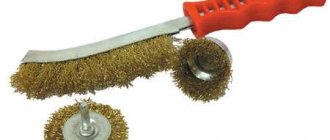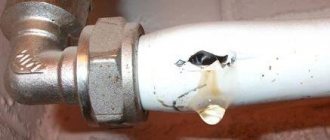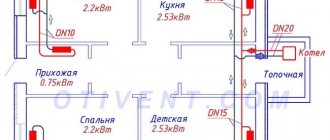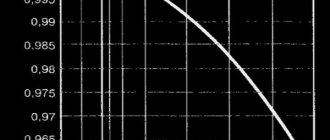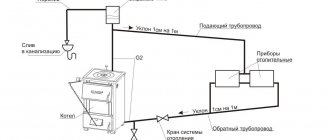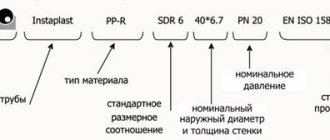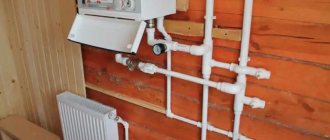There are hundreds of connections in any heating system. This is a connection of pipes and radiators, ball valves, circulation pumps and expansion tanks. In sectional batteries, the weak point is the connection of the sections to each other through a gasket; in the presence of heated floors, additional threaded connections appear between the boiler and the collector and between the collector and the floor heating system.
All these connections are checked after installation, i.e. the heating system is pressurized with air. SNiP clearly and unambiguously stipulates the norms for pressure testing of heating systems. Technically, pressure testing is carried out by creating high air or water pressure in the system to detect defects and coolant leaks.
Pressure testing the system and removing air from the circuit
After completing the installation work to create the heating system, it is disconnected from the boiler, the hermetic expansion tanks are turned off, and in open systems the expansion tanks are sealed. This is how we prepare to check the heating circuit for its functionality. The operation of testing a heating system with high pressure is called pressure testing. It can be carried out either with air or with the help of hydraulic pumps with water.
According to SNiP standards, crimping is mandatory:
- when putting a new system into operation;
- after replacing system elements (risers, batteries, pipes);
- in preparation for the heating season.
In accordance with the rules of SNiP, a crimping test report is drawn up. In newly installed circuits, air pressure testing of the home heating system is most often performed. It is believed that after crimping, if no defects requiring elimination have been identified, then the system is completely ready for operation. After completing the system tests, filling the system with water usually begins. It is very likely that another problem will arise - it will be necessary to bleed air from the heating system, which will inevitably disrupt the operation of the entire circuit.
Air that has entered the heating system disrupts the circulation of the coolant, causes uneven heating of the batteries, and reduces the efficiency of the circuit. The analysis of the causes and the answer to the question of where the air in the heating system comes from is ambiguous. There are many reasons, the main ones:
- violation of installation rules;
- improper filling of the heating system;
- poor sealing of joints, threaded connections and seams;
- hit during repair work;
- malfunction of air vents;
- low pressure in the circuit;
- release of dissolved air from the coolant during heating.
How to carry out crimping correctly
Pressure testing of heating systems is carried out in accordance with the requirements of certain documents, which indicate what pressure is used to pressurize the heating system. In particular, we are talking about Sanitary Standards and Rules numbered 41-01-2003 (air conditioning, ventilation and heating) and 3.05.01-85 (Internal sanitary systems).
According to SNIP 41-01-2003, pressure testing of the heating system is carried out only if the room temperature is above 00C. In addition, the system must withstand a pressure of the working medium of at least 0.6 MPa, while damage and leakage are not allowed.
Pressure testing is carried out under pressure, the value of which does not exceed the limit values for heating devices, pipelines and fittings built into the system.
In order not to violate SNIP 3.05.01-85, before checking water heating systems, expansion vessels and boilers should be turned off. According to SNIP, the pressure during pressure testing of the heating system should be 1.5 times higher than the operating pressure, but not less than 0.2 MPa at the lower level of the system.
For a positive test result, the network must last about 5 minutes under the recommended test pressure, and its value should decrease by no more than 0.02 MPa. Also, during a visual inspection of the system elements, no leaks should be detected in threaded connections and welds, pipes and fittings, heating devices and other equipment.
Air bleeding devices
Air that appears in the circuit for one reason or another must be removed. To bleed air trapped in the system, use a heating air vent, which can be manual or automatic.
Manual air vent
A manual air vent, better known as a Mayevsky tap, is installed only in apartments on heating radiators due to its low throughput. Typically, such valves are installed on all radiators, and they ensure the bleeding of air from the heating system during setup and operation.
Automatic air vent
Automatic float-type air vents operate as follows. If the system is operating in normal mode, the float completely closes the valve opening, but if an air lock occurs in the system, the float opens the valve. The open valve of the automatic air vent releases air from the heating system, then rises again and closes the valve. Of course, the use of automatic air vents facilitates the operation of systems, but they require systematic maintenance and cleaning of various contaminants present in the water.
Call specialists or do it yourself
If for some purpose you require a pressure test certificate for your heating or hot water supply system, you have only one option - order this service from a specialized organization. The cost of heating pressure testing can only be quoted to you individually. It depends on the volume of the system, its structure, the presence of shut-off valves and their condition. In general, the cost is calculated based on the tariff for 1 hour of work, and it ranges from 1000 rubles/hour to 2500 rubles/hour. You will have to call different organizations and inquire with them.
Companies involved in hydraulic system testing have more serious equipment.
If you have upgraded the heating or hot water supply of your own home, and you know for sure that your pipes and equipment are in good condition, there are no salts or deposits in them, you can carry out pressure testing yourself. No one will demand hydraulic test certificates from you. Even if you see that your pipes and radiators are clogged, you can wash everything yourself and then test it again. If you just don’t want to do this, you can call specialists. They will immediately clean the system and pressure test it, and will also issue you a certificate.
Certificate of hydrostatic testing of the system (pressure testing)
Signs of air locks
The first sign of air in the system is poor heating of the batteries. The battery warms up unevenly, not enough, and if any sounds appear in it, then the answer is clear - the air in the heating radiators is preventing the circuit from working properly. If the radiators have a bottom connection, and its upper part is cold, then air has accumulated in such a radiator and bleeding the air from the heating radiator will restore normal operation.
Removing air from heating circuits
There is a lot written on the Internet about what needs to be done and how to remove air from a heating battery. For open heating systems with an expansion tank, this problem is not relevant. In such systems, the air exits independently through a tank located at the highest point of the circuit. Problems with some radiators may arise, especially if the slope is chosen incorrectly. Such air bubbles are removed using Mayevsky taps or automatic air vents.
For closed systems with forced circulation, the problem of how to get rid of air in the heating system is also completely solvable. Air is removed from the batteries manually by opening the Mayevsky tap. If you hear a hissing sound when you open it, then the actions are correct and there is air in the system. The air must be released until water appears at the outlet of the Mayevsky tap.
The most dangerous air locks are at bends and turns of pipelines.
Such accumulations of air can completely stop the circulation of water in the system. If the installation of problematic areas of the circuit, for some reason, cannot be changed, then a heating system air bleed valve is installed in such problematic areas to bleed it.
Features of aluminum radiators
An unpleasant phenomenon is sometimes observed in aluminum radiators. The radiator material reacts with water. As a result, gases are constantly formed and must be constantly removed from the radiator, and how to remove air from a heating battery is described above. To avoid the problem described above, it is enough to buy and install aluminum radiators with an internal anti-corrosion coating. The correct solution would be to replace the aluminum radiator with a bimetallic one.
Pressure testing of water supply and heating systems - how is it done?
As a rule, the process of monitoring the integrity of pipes and the quality of joints using the crimping method can be implemented in the process of performing the following actions.
Action one: covering and sealing the controlled area. At this stage, we cut off the pipeline branch to be pressure tested from the central line of the water pipeline. To do this, you need to shut off the shut-off valves (taps or valves) at the end and beginning of the section. Well, for sewers, special plugs made of plastic, rubber or wood are used.
Step two: connecting to the controlled area a source that pumps pressure. Moreover, either a special pump for pressure testing pipes or a conventional pump responsible for circulating fluid in the system is used as such a source.
The pressure source (pump) is connected to a special outlet (pipe), the presence of which was provided for during the pipeline design process:
- Pressure testing of the heating system is carried out using special taps attached to each battery,
- the water supply can be pressurized through the connection pipe of the hot or cold water tap,
- with sewerage it is even simpler - the sediment fitting is inserted into the inspection - a special tee mounted in the outlet pipeline in increments of 40-50 meters.
The accuracy of the results and operating time depend on the power of the pump. After all, a low-power pump will increase the testing time - a simple pipe crimper will not be able to quickly fill a large pipe with the required volume of air, and a leaky joint will distort all the results of our tests.
Sequence of air removal in high-rise buildings
For multi-storey buildings, the problem of when and how to properly bleed air from the heating system is solved as follows. Air usually rises and accumulates in radiators and piping on upper floors. But before the heating season, checking and removing air must be done sequentially, starting from the lower floors.
If you install an automatic air vent for heating radiators on the heating radiator and in problem areas, it will ensure air bleed. Of course, you can check the system manually, it won’t make you worse, because... the valve may become dirty or stuck, which will prevent the automatic release of air from the heating system and disrupt the operation of the circuit.
What is pressure testing of heating and water supply systems?
Heating and water supply are two systems consisting of a large number of varied equipment. As you know, the performance of any multicomponent system is determined by the weakest element - if it fails, it stops completely or partially. To identify all weak points, pressure testing of heating and water supply is carried out. In simple terms, the pressure deliberately rises much higher than the working one, pumping liquid. This is done using special equipment; the pressure is controlled using a pressure gauge. The second name for crimping is hydraulic testing. It's probably clear why.
Heating pressure testing is carried out after any repair or before the heating season
When a heating system is pressure tested, the pressure is increased by 25-80% depending on the type of pipes, radiators, and other equipment. It is clear that such a test reveals all the weak points - everything that does not have a safety margin breaks, leaks appear in worn pipes and unreliable connections. Having eliminated all identified problems, we ensure the functionality of our heating or water supply for some time.
If we are talking about centralized heating, then pressure testing is usually carried out immediately after the end of the season. In this case, there is a decent period of time for repairs. But this is not the only case when such events are held. Pressure testing still takes place after repairs or replacement of any element. In principle, this is understandable - we need to check how reliable the new equipment and connections are. For example, you soldered heating from polypropylene pipes. We need to check how high quality the connections are. This can be done using crimping.
If we talk about autonomous systems in private houses or apartments, then a new or repaired water supply is usually checked simply by turning on the water, although even here a strength test would not hurt. But it is advisable to test the heating “to its fullest”, both before commissioning and after repairs. Keep in mind that those pipelines that are hidden in walls, floors or suspended ceilings must be tested before they are closed. Otherwise, if during testing it turns out that there are leaks there, you will have to disassemble/break everything and fix the problems. Few people will be happy about this.
Air separator, what is it?
Air separators or their other name - air collectors for heating systems are designed to remove air from the coolant that circulates in the circuit. It is used for systems of any type, in underfloor heating systems and in heat pumps. Water is passed through a separator to remove dissolved gases and various contaminants that adversely affect the system and contaminate various valves. An air separator makes the question of how to properly remove air from a heating system completely irrelevant. But to increase the reliability and durability of the system, a separator and manual or automatic air vents are installed in the heating system of a home or business.
Air separators have many useful properties that improve heating circuits:
- installing a separator improves heat transfer;
- high reliability due to the extreme simplicity of the design;
- significant improvement in water quality in the circuit;
- cleaning of accumulated contaminants can be done without stopping the system;
- low cost and ease of installation;
- removal of the smallest particles of dirt from the coolant.
Consequently, the answer to the popular question - how to bleed air from the heating system - is simplified. There will be so little air in the system that tiny traces of it can be easily removed manually. For this purpose, Mayevsky taps and automatic air vents are used. There is a fundamental difference between manual and automatic air vents. The Mayevsky crane removes, for example, air pockets that have accumulated at the highest points.
The separator extracts the air dissolved in the water and removes it.
That is, when heating the water that has passed through the separator, no air will be released. Of course, using a separator for small systems is expensive; removing air manually can be done easily and simply. Air separators are most widely used in complex, large heating circuits. If you decide to buy an air separator for heating, the price will depend on the performance, ranging from 3,000 to 40,000 rubles.
Equipment and test frequency
Pressure testing of centralized systems is carried out by personnel using standard equipment, so it is hardly worth talking about. But not everyone probably knows about the costs of private heating and water supply. These are special pumps. There are two types - manual and electric (automatic). Manual pressure testing pumps are autonomous, the pressure is pumped up using a lever, and the created pressure is controlled using a pressure gauge built into the device. Such pumps can be used for small systems - pumping is quite difficult.
Manual crimping machine
Electric pumps for pressure testing are more complex and expensive equipment. They usually have the ability to create a certain pressure. It is set by the operator, and it is “caught up” automatically. Such equipment is purchased by companies engaged in professional crimping.
According to SNiP, hydraulic testing of heating systems must be carried out annually, before the start of the heating season. This applies to private houses too, but few people comply with this standard. At best, they check it once every 5-7 years. If you are not going to test your heating annually, then there is no point in buying a pressure tester. The cheapest manual one costs about $150, and a good one costs from $250. In principle, you can rent it (usually from companies that sell components for heating systems or from offices that rent equipment). The amount will be small - you need the device for several hours. So this is a good solution.
What to do if the system does not work?
It may happen that the most careful removal of air plugs, installation of automatic air vents and even a separator does not bring the desired results. After some time, the system begins to work poorly, air pockets appear, which need to be removed again and again. In this case, only pressure testing of the heating system will help. SNiP clearly defines the procedure and methods of verification. Pressure testing will help to find places where air is leaking, lack of tightness of fittings and circuit connections and other shortcomings. After careful pressure testing, heating systems usually operate for a long time and reliably.
Carrying out tests in private homes
It is worth noting that in autonomous heating networks, which are used in private homes, the pressure is usually no more than 2 bar. Therefore, in order to carry out tests, it is necessary to pump liquid into the system at a pressure of 3.5-4 bar. It is allowed to use both air and hydraulic methods of crimping.
Sequence of testing work:
- First, drain the coolant and pump pressurized water into the heating system circuit. It is imperative to add additives that are used when flushing the system. The circuit is filled with water through a pipe located at the bottom.
- Before washing, the filters must be thoroughly cleaned. It is recommended to carry out washing at least once a year.
- Next, drain the flushing fluid and fill the system with clean fluid. You can skip this step if you let the washing liquid cool to 45 degrees. After this, you need to use a pressure testing device to pump in more water to bring its pressure to 4 bar.
- If you use a manual pressure tester, then fill its tank with liquid, then connect it to the drain pipe of the heating system circuit. Next you need to open the taps and pump in water. This is done simply - you need to raise and lower the handle of the device. As soon as the required pressure is reached, close all valves.
- Leave the entire system filled for about half an hour and carefully monitor the pressure. If there is a drop of less than 0.2 bar over a period of 30 minutes, we can say there are no leaks. If the pressure drop is too large, then the defects need to be found and eliminated.
Remember that it is imperative to comply with the permissible pressure standards when performing pressure testing. It should also be noted that there is a high probability of leaks occurring inside the walls. In this case, you will need a thermal radiation meter. Only he is able to determine the presence of hot liquid leaks in the walls or under the floor.
Some may ask the question: “What pressure should be maintained when pressurizing a heating system with air?” Air is not a liquid, so it is allowed to pump about 2 bar into a system whose length is no more than 10 meters. But it all depends on the specific heating system, its length and volume. If it is relatively small, then the test pressure can be reduced.
Source
Work order
You can carry out pressure testing of your home water supply yourself.
- Seal the section of line being tested. To do this, close the shut-off valves at the end and beginning of the section.
- Disconnect system elements not designed for test pressure - safety valves and other fittings, boiler, boiler, expansion tanks.
- Connect the pressure equipment. The pump is connected to the hot or cold water tap. In heating networks - to the radiator tap.
- Pump water or air through the check valve.
- Monitor the pressure using a pressure gauge. For cast iron pipes it should be 1.5 atmospheres, for non-pressure plastic products - 1.5-2, for pressure ones - 10-15. When checking heating networks in private homes, 2 atmospheres is sufficient.
- Turn off the pressure tester and record the primary value on the measuring device and leave the system for 6–8 hours.
After the control time has passed, it is necessary to compare the initial indicator with the current result. If the first one is lower, there is a problem with the water supply system.
If the line is tested with water flow, leaks are easy to detect. When air crimping, all connecting nodes are coated with a soap solution. Bubbles appear at the leak site. After troubleshooting, testing is performed again.
Air crimping
Not everywhere and not always is it possible to rent a crimping machine, just as it is not possible to buy one. For example, you need to test the heating in your dacha. The equipment is specific and the chances that someone you know has it is very low. In this case, pressure testing of the heating system is carried out with air. To pump it, you can use any compressor, even a car one. The pressure is monitored using a connected pressure gauge.
This type of crimping is less convenient and not entirely correct. Heating and plumbing are designed to transport liquids, which are much denser than air. Where water will not even ooze out, air will escape. Therefore, we can say with a high degree of confidence that you will have an air leak - somewhere there will be a loose connection. Moreover, it is difficult to determine the location of the leak during such testing. For this purpose, use a soap solution, which coats all joints and connections, all places where air can escape. Bubbles appear at the leak site. Sometimes you have to search for a long time. This is precisely why such pressure testing of the heating system is not very popular.
Pressure testing of a heated floor has its own characteristics - you must first check the comb and all the devices attached to it. To do this, close all the supply and return valves of the loops, filling only the heated floor manifold, and check it by raising the pressure. Having reset it to normal, the heated floor loops are filled one by one, and only then is excess pressure created. The process is described in more detail in the video.
Source

